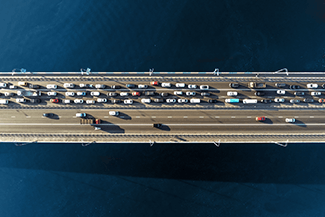OECD Workshop on Microplastics from Tyre Wear: Knowledge, Mitigation Measures, and Policy Options

Scientists are gathering mounting evidence that microplastics, i.e. plastic particles whose diameter is below 5mm, are everywhere – from the remotest mountains and the deepest parts of the ocean, to our local rivers, drinking water, food products and the air we breathe.
Microplastics originating from tyres are estimated to be one of the largest contributors to microplastics pollution in terms of volumes released to the rivers and oceans. During road transport activity, the friction between the road surface and the tyres results in the abrasion of tyres (and of road surfaces) and in the emission of particles into the surrounding aerial, terrestrial, and aquatic environments. The result of this friction are particles containing a mixture of synthetic polymers and other tyre tread and road pavement material, generally referred to as Tyre and Road Wear Particles (TRWP). Further, certain end-of-life options for the disposal of old tyres may also contribute to microplastics pollution. In particular, when rubber crumb from used tyres is re-used as infill material for artificial sports turfs and playgrounds, this may leak out and contribute to microplastics pollution of water bodies.
Policymakers need tools and instruments that contribute to effective management of tyre-based microplastics. The purpose of this workshop was be to gather environmental policy makers, academics, industrial representatives, water and wastewater utilities, IGOs and civil society to discuss mitigation options for environmental pollution from tyre and road wear particles.
The workshop, by invitation only, aimed to address the following topics:
1) The state of scientific knowledge on the environmental fate of tyre and road wear particles and other microplastics originating from tyres, and their impacts on aquatic ecosystems and human health.
2) Mitigation options to prevent the leakage of Tyre and Road Wear Particles.
3) Options for the safe management of end-of-life tyres.
4) Technologies to capture TRWPs from wastewaters, stormwater, and road runoff.
5) Policy instruments and industry-led initiatives to support the diffusion of mitigation options.
Publication
 |
The workshop informed the development of the OECD report “Policies to Reduce Microplastics in Water: Focus on Textiles and Tyres”. Microplastics are ubiquitous in the natural environment. This report synthesises the current state of knowledge on the sources, fate and risks of microplastics pollution. It then focuses on two sources of microplastics pollution, textile products and vehicle tyres, due to their substantial contribution to global microplastics emissions and currently largely absent policy frameworks to mitigate them. Several best practices and technological solutions can be implemented along the lifecycle of textile products and vehicle tyres to mitigate releases to the environment. The report proposes policy insights on measures and strategies that could help minimise microplastics emitted unintentionally from products and their potential impacts on human health and ecosystems. |
Engage with us
- Join the conversation on Twitter: @OECD_ENV │ #Microplastics │ #WaterPollution
- Contact: elena.buzzi@oecd.org



